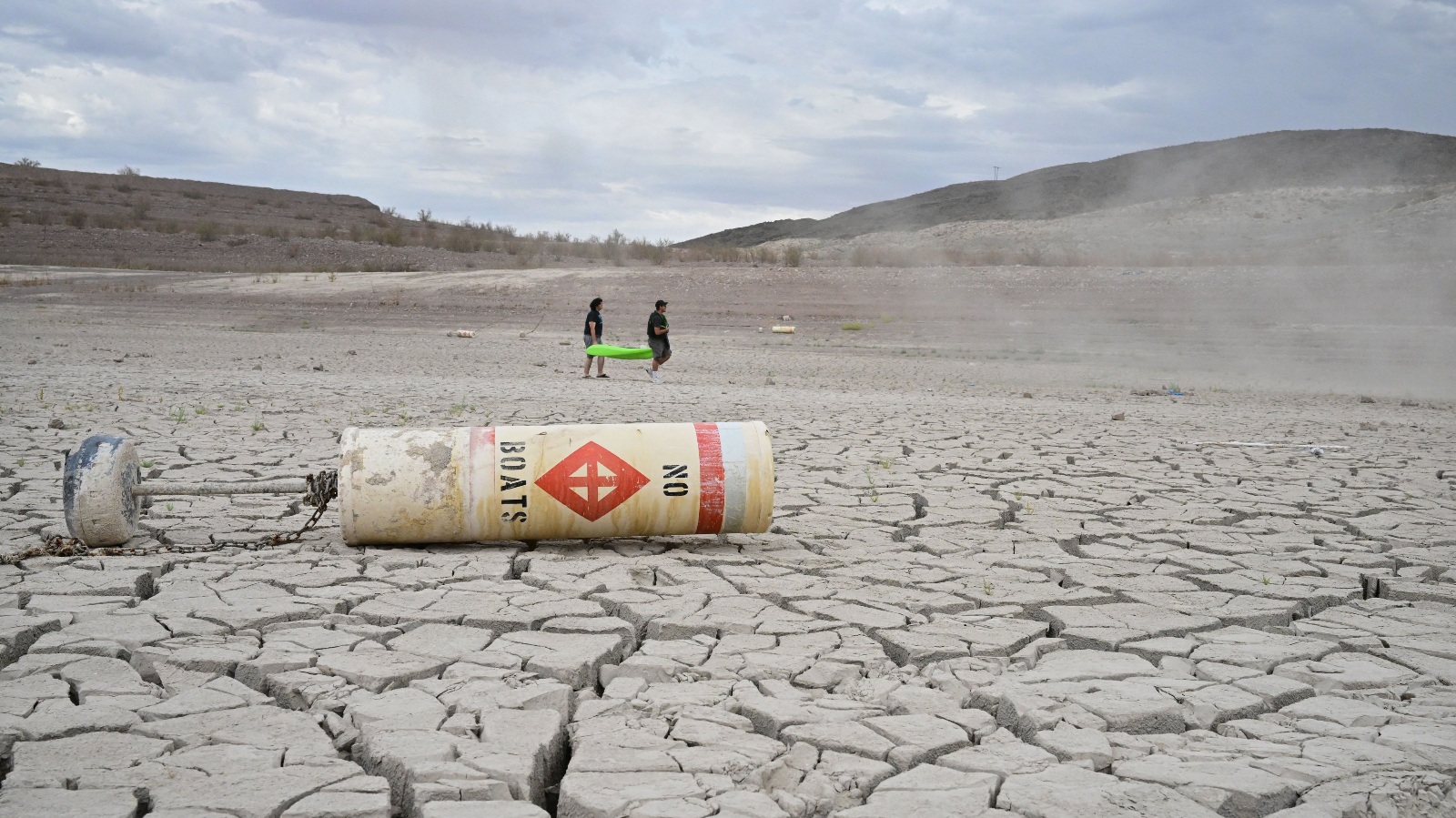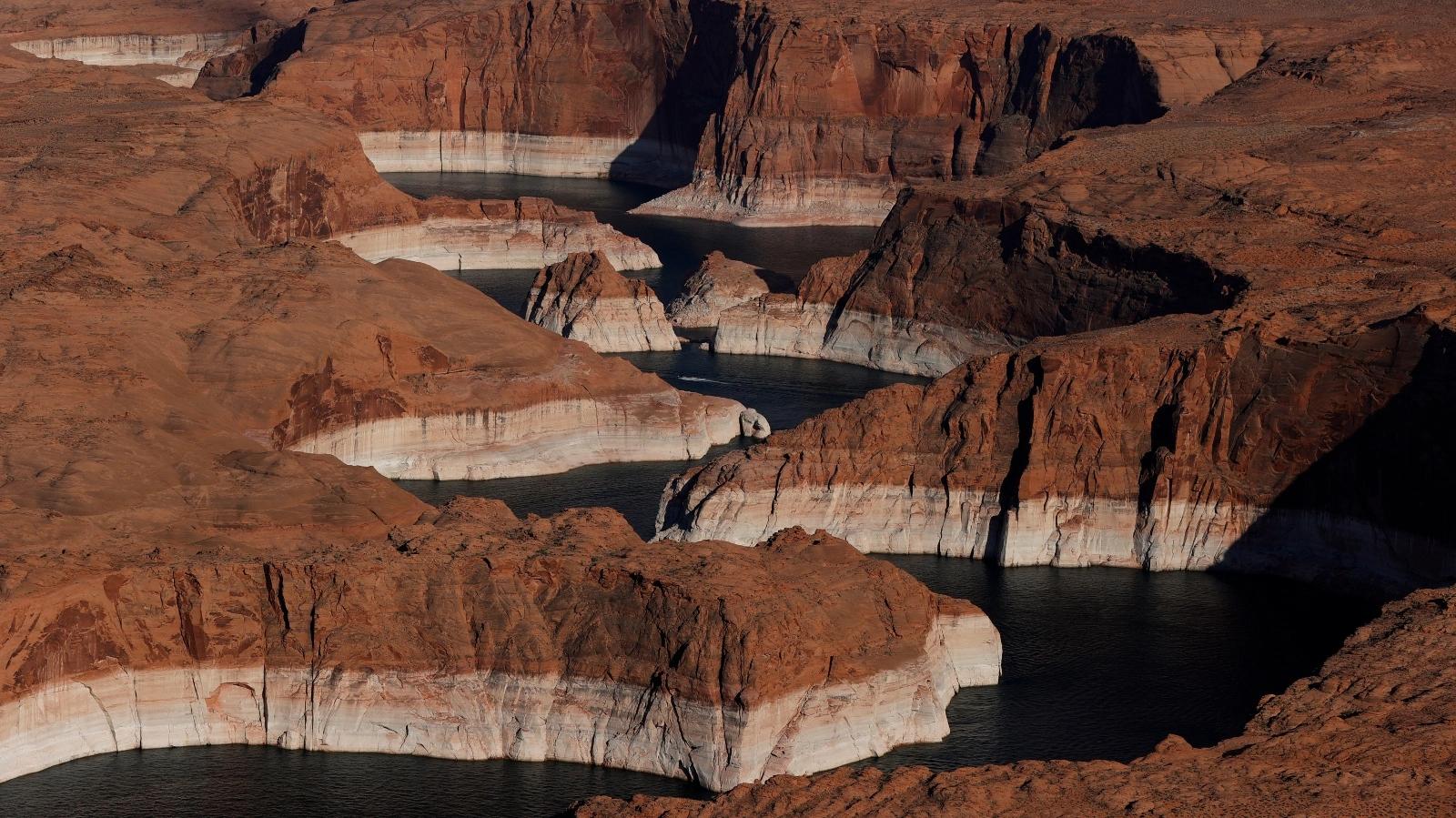This story is part of the Grist series Parched, an in-depth look at how climate change-fueled drought is reshaping communities, economies, and ecosystems.
The Interior Department announced sweeping changes on Tuesday to the way Colorado River water is doled out in the western United States and Mexico in response to the climate change-fueled megadrought that is desiccating freshwater resources in the region.
For the first time ever, federal officials declared a Tier 2a water shortage, which requires Arizona, Nevada, and Mexico to reduce the amount of water they draw from Lake Mead starting at the beginning of next year. Arizona will have to reduce its water withdrawals by 21 percent, Nevada by 8 percent, and Mexico by 7 percent; California, the largest water user on the river, avoided taking any cuts.
“The system is approaching a tipping point,” Bureau of Reclamation Commissioner Camille Calimlim Touton said at a press conference. “Without action, we cannot protect the system and the millions of Americans who rely on this critical resource.”
The federal government already issued a first-of-its-kind Tier 1 shortage declaration for Colorado River operations last year. That declaration required Arizona, Nevada, and Mexico to cut their water intake from the river in accordance with a drought contingency plan signed back in 2019; Arizona took the greatest cut and had to reduce water deliveries to its cotton and alfalfa farmers. The new Tier 2a declaration imposes further cuts on the same states, and again the cuts fall hardest on Arizona. The state will lose around 80,000 additional acre-feet of water this time, on top of the 500,000 acre-feet it lost in the last round — one-fifth of its total allotment combined. (An acre-foot is equivalent to about 320,000 gallons.)
Nevada and Mexico will also see reductions in this year’s round of cuts, though far fewer. The effects on Nevada will likely be minimal, since the state has conserved an enormous amount of Colorado River water over the last several years in anticipation of a shortage, but the effects on Mexico will likely be more significant, since the country uses river water to sustain agriculture in the Mexicali Valley.
The new water cuts are determined by the latest available water data. Every month, Reclamation releases a report that forecasts water levels in the Colorado River Basin for the next two years. The August report is special; by this time of the year, the snow that accumulated over the previous winter has melted, and the federal government has a clear sense of just how much of that water has made it into the river’s two major reservoirs, Lake Powell and Lake Mead. It’s the August water level in Lake Mead that determines what cuts Reclamation imposes on the Lower Basin states of Arizona, Nevada, California, and Mexico.

While the bulk of the cuts from last year’s Tier 1 shortage fell on Arizona farmers, this newest round of cuts will also impact other water users, including the Gila River Indian Community and the city of Phoenix. The new cuts won’t shut off any taps, but they will deprive these water users of their excess water rights, leaving them with less wiggle room to deal with future shortages, and could lead to lawn-watering restrictions as cities try to adapt to the drought. If water levels in Lake Mead fall 20 feet further, it will trigger a Tier 3 shortage, which would cut California’s massive water allotment for the first time; the Golden State water rights are senior to those of other Lower Basin states, which has allowed it to avoid water cuts in previous rounds.
(Lake Mead’s actual elevation is even lower than Reclamation announced on Tuesday, but the government is pretending for the moment that there’s some extra water in the reservoir, thanks to some creative accounting measures it imposed in June to protect Lake Powell. The true elevation of the reservoir is low enough to trigger an even further round of cuts, the so-called “Tier 2b” shortage, but the government is holding off on those cuts for now.)
Just two decades ago, a shortage of this magnitude on the Colorado River seemed unthinkable. Modern life in the western U.S. is predicated on the assumption that water will always flow in the Colorado – and that the U.S. can always engineer solutions to the occasional drought.
For more than a century, that assumption held. The years between 1980 and 2000, especially, were a time of plenty in the Colorado River Basin. Reliable seasons of rain and snowpack filled Lake Mead and Lake Powell to the brim, supplied the region’s growing populations with water and hydroelectric power, and sustained the wildlife and plants that depend on the Colorado for survival. But then drought descended on the arid West, and water managers in the seven Colorado River Basin states started talking about what would happen if the reservoirs went dry. At first, those conversations were hypothetical, but 23 years of nearly unbroken drought later, both Lake Powell and Lake Mead are at critically low levels. The megadrought in the western U.S., fueled by climate change, is officially the worst drought in 1,200 years, according to scientists. It threatens to completely transform the region.
“We are now truly out of time,” Jennifer Pitt, Colorado River program director for the National Audubon Society, told Grist. “All of the water managers in this basin are facing this moment when action is necessary.”
Further cuts may be on the horizon, and for the whole basin rather than a select few states. Earlier this summer, Touton told the seven Colorado River states that they would have to conserve between 2 and 4 million acre-feet of water in the next year in order to stabilize Lakes Powell and Mead. This would require the states to reduce their water usage by 15 to 30 percent in addition to the reductions they’ve already made as part of the 2019 Drought Contingency Plan. If the states didn’t find 2 million acre-feet of savings by mid-August, Touton said at the time, the federal government could “act unilaterally to protect the system,” imposing long-term water restrictions over and beyond the new cuts to the Lower Basin states.
The states blew past Touton’s deadline, but it isn’t clear yet whether the federal government will intervene and force another round of cuts, or which states would absorb those cuts. At Tuesday’s press conference, Reclamation officials only issued vague calls for “basin-wide conservation” beyond the cuts brought about by the Tier 2a declarationbeyond the cut Tier 2 declaration.
Representatives from the Colorado River states met last week in Denver to negotiate potential water cuts, but that the meeting ended without an agreement. Participants from the meeting told the Los Angeles Times that the cuts proposed by the negotiators totaled less than the 2 million acre-feet Touton demanded in June.
The Lower Basin states use the lion’s share of Colorado River water, and they claim they’ve made generous water reduction proposals in recent weeks as the states try to meet Touton’s demands. In a press release on Tuesday, Arizona officials said that they offered to reduce the state’s water withdrawals by 2 million acre-feet next year, but said that the federal government rejected that proposal. It isn’t clear what other conditions Arizona requested as part of this offer, but the rejection appears to indicate that the federal government wanted the Lower Basin states to absorb even further cuts. Two large water districts in Southern California, meanwhile, have mulled reducing their water withdrawals by another half million acre-feet.
“Despite the obvious urgency of the situation, the last 62 days produced exactly nothing in terms of meaningful collective action,” said John Entsminger, the general manager of the Southern Nevada Water Authority, in a letter to the federal government earlier this week.
Meanwhile, the Upper Basin states — Colorado, Wyoming, Utah, and New Mexico — have refused to make any definitive commitments; the states told the federal government in June that “additional efforts to protect critical reservoir elevations must include significant actions focused downstream [in the Lower Basin],” and promised only that the states would consider reviving some dormant water conservation programs.
The negotiations between lower and upper basin states will continue in the coming weeks and months. Pitt, from Audubon, said she was heartened by the Reclamation Bureau’s actions on Tuesday.
“It’s hard to know whether it will be ‘enough,’” she said, “but they indicate they will be taking unprecedented steps, which is what this moment calls for.”


